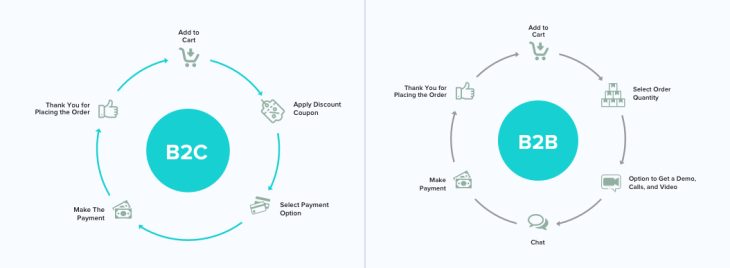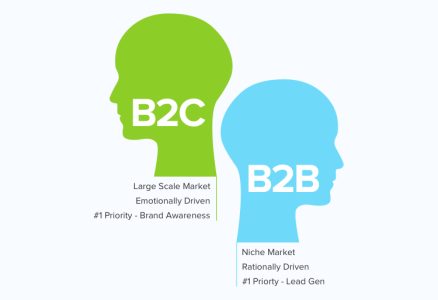


The difference between B2B and B2C is huge, but only if you notice the little & minute things that make the difference. To start with, there are some factors to take into consideration.
In today’s dynamic world, as an eCommerce player, driving sales on your platforms and churning out higher revenues, mandates a clear-cut focus on your customers. And that’s not as straight forward as you might think! To be honest, there are two facets to your target audience.
On one side, there is the business-to-consumer (B2C) setup, where the “consumer” is the target who buys products/services directly from the business. On the other side, there is the business-to-business (B2B) setup, where one business sells to another, which in turn sells to the consumers.
B2C: The ultimate aim of B2C websites is to attract visitors who can then be converted into customers. For that, a much-thought-about strategy needs to fall into place that speaks in favor of users.
The features of B2C eCommerce homepage should include:
B2B: The ultimate motive of the B2B eCommerce platform is to attract other businesses who can, in turn, form a long term alliance with them. The main focus is on solving business problems.
A B2B homepage should include:

B2C: The end-user does not have much to invest when making a purchase online. Their decision is self-driven without being answerable to anyone. Customer service is essential in B2C eCommerce as well.
Major elements that B2C eCommerce development efforts should include:
B2B: In B2B business platforms, larger orders are involved. Talking physiologically, a business investing a larger part of their resources need to be well-informed.
Major elements that B2B eCommerce developer should include:

B2C: The last step of any transaction is the checkout process. In a B2C setup, the flow is simple, i.e., smoothly navigating a customer from “Add to Cart” to “Thank you for placing the order.”
Major elements that a B2C checkout should include:
B2B: In the B2B model in eCommerce, the checkout process should be an amalgamated version of automated pre-programmed checkout steps and live human assistance.
Major elements that help figure out the difference between B2B and B2C checkout should include:
B2C: An end user who is buying a product for personal use is the target here. Though the target audience here does not need to have an insight into the factual data, they still need to stay updated as transparency of information is a major parameter that instigates purchases.
Major elements that B2C informative assets should include:
B2B: Getting a lead and nurturing it till it gets converted is the aim of any B2B business. And, that is why having effective informative assets in place is essential to guide the lead through.
Major elements that a B2B eCommerce developer should focus on:
B2C: In a B2C eCommerce platform, the pricing is consistent across the catalog without being bias to any target group. The only variance in the pricing model comes in the form of first-time purchase offers, discount coupons, seasonal sales, and clearance sales.
Basic features for a successful B2C website:
B2B: If the difference between B2B and B2C is analyzed, a B2B eCommerce business happens to offer a personalized shopping experience to its customers for they need to keep them engaged over a long time. That is why; B2B eCommerce platforms rely on special pricing based on quantity, volume, and frequency of orders made.
Basic features for adjusting a dynamic pricing model:
B2C: There is no minimum order quantity parameter that needs to be taken into account when placing an order on a B2C eCommerce platform. However, there is this maximum order quantity that comes into play in retail eCommerce websites.
Requirements for designing MOQ for a B2C platform:
B2B: Minimum order quantity (MOQ) is the main requirement that any B2B eCommerce platform needs to cover. Because placing a “single item” order is simply not allowed in this wholesale oriented business.
Requirements for designing MOQ for a B2B platform:

B2C: A buyer who is purchasing on an individual basis is independent enough to make his own decisions. They are the masters of their own decisions where they do not have to seek permission to make a purchase.
What to consider while designing for a B2C buyer:
B2B: Here the buyer is a sales representative of a business! But, the decision to buy does not depend on that individual alone. There are multiple parties involved: product/service users and the decision-makers of the business.
What to consider while designing for a B2B buyer: